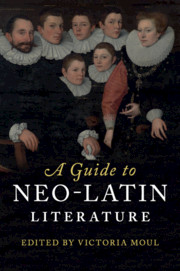Book contents
- A Guide to Neo-Latin Literature
- A Guide toNeo-Latin Literature
- Copyright page
- Dedication
- Contents
- Illustrations
- Contributors
- List of Neo-Latin Authors and Dates
- Acknowledgements
- Introduction
- Part I Ideas and Assumptions
- Part II Poetry and Drama
- Part III Prose
- Part IV Working with Neo-Latin Literature
- Bibliography
- Index
- References
Bibliography
Published online by Cambridge University Press: 02 March 2017
- A Guide to Neo-Latin Literature
- A Guide toNeo-Latin Literature
- Copyright page
- Dedication
- Contents
- Illustrations
- Contributors
- List of Neo-Latin Authors and Dates
- Acknowledgements
- Introduction
- Part I Ideas and Assumptions
- Part II Poetry and Drama
- Part III Prose
- Part IV Working with Neo-Latin Literature
- Bibliography
- Index
- References
- Type
- Chapter
- Information
- A Guide to Neo-Latin Literature , pp. 408 - 473Publisher: Cambridge University PressPrint publication year: 2017



